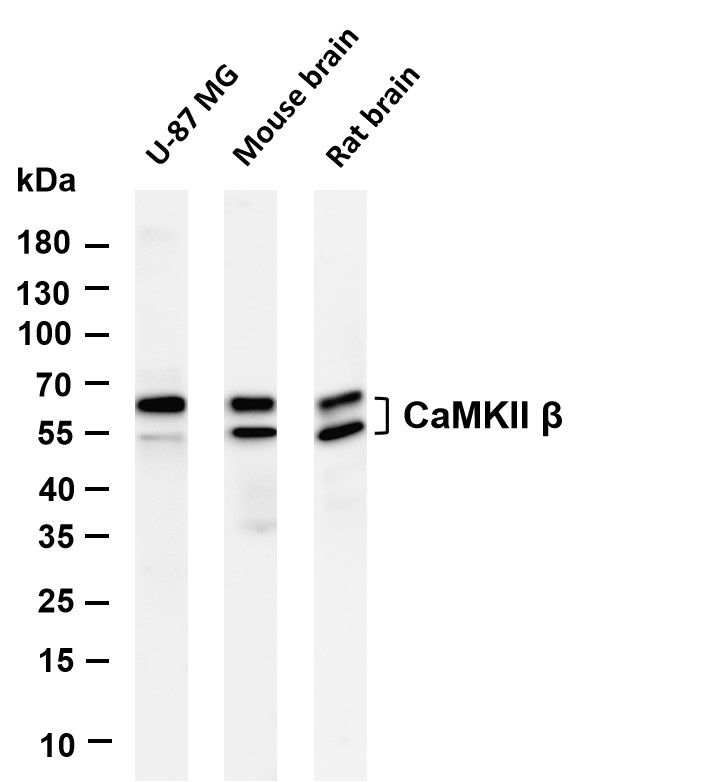CaMKII β (PT0491R) PT® Rabbit mAb
- Catalog No.:YM8323
- Applications:WB;IF;IP;ELISA
- Reactivity:Human; Mouse; Rat;
- Target:
- KCC2B
- Fields:
- >>ErbB signaling pathway;>>Calcium signaling pathway;>>cAMP signaling pathway;>>HIF-1 signaling pathway;>>Oocyte meiosis;>>Necroptosis;>>Adrenergic signaling in cardiomyocytes;>>Wnt signaling pathway;>>Axon guidance;>>Circadian entrainment;>>Long-term potentiation;>>Neurotrophin signaling pathway;>>Cholinergic synapse;>>Dopaminergic synapse;>>Olfactory transduction;>>Inflammatory mediator regulation of TRP channels;>>Insulin secretion;>>GnRH signaling pathway;>>Melanogenesis;>>Oxytocin signaling pathway;>>Glucagon signaling pathway;>>Aldosterone synthesis and secretion;>>Cushing syndrome;>>Gastric acid secretion;>>Parkinson disease;>>Pathways of neurodegeneration - multiple diseases;>>Amphetamine addiction;>>Tuberculosis;>>Pathways in cancer;>>Proteoglycans in cancer;>>Glioma;>>Diabetic cardiomyopathy;>>Lipid and atherosclerosis
- Gene Name:
- CAMK2B CAM2 CAMK2 CAMKB
- Protein Name:
- Calcium/calmodulin-dependent protein kinase type II subunit beta (CaM kinase II subunit beta) (CaMK-II subunit beta) (EC 2.7.11.17)
- Human Gene Id:
- 816
- Human Swiss Prot No:
- Q13554
- Mouse Swiss Prot No:
- P28652
- Rat Swiss Prot No:
- P08413
- Specificity:
- endogenous
- Formulation:
- PBS, 50% glycerol, 0.05% Proclin 300, 0.05%BSA
- Source:
- Monoclonal, rabbit, IgG, Kappa
- Dilution:
- WB 1:2000-1:10000;IF 1:200-1:1000;ELISA 1:5000-1:20000;IP 1:50-1:200;
- Purification:
- Protein A
- Storage Stability:
- -15°C to -25°C/1 year(Do not lower than -25°C)
- Molecular Weight(Da):
- 54kD
- Observed Band(KD):
- 54kD,60kD
- Background:
- The product of this gene belongs to the serine/threonine protein kinase family and to the Ca(2+)/calmodulin-dependent protein kinase subfamily. Calcium signaling is crucial for several aspects of plasticity at glutamatergic synapses. In mammalian cells, the enzyme is composed of four different chains: alpha, beta, gamma, and delta. The product of this gene is a beta chain. It is possible that distinct isoforms of this chain have different cellular localizations and interact differently with calmodulin. Alternative splicing results in multiple transcript variants. [provided by RefSeq, May 2014],
- Function:
- alternative products:The variable region of the CAMK2B protein is encoded by at least 7 exons (V1 to V7). Alternative splicing within this region gives rise to CAMK2B isoforms,catalytic activity:ATP + a protein = ADP + a phosphoprotein.,enzyme regulation:Autophosphorylation of CAMK2 plays an important role in the regulation of the kinase activity.,function:CaM-kinase II (CAMK2) is a prominent kinase in the central nervous system that may function in long-term potentiation and neurotransmitter release. Member of the NMDAR signaling complex in excitatory synapses, it may regulate NMDAR-dependent potentiation of the AMPAR and synaptic plasticity.,similarity:Belongs to the protein kinase superfamily.,similarity:Belongs to the protein kinase superfamily. CAMK Ser/Thr protein kinase family. CaMK subfamily.,similarity:Contains 1 protein kinase domain.,subunit:CAMK2 is composed of four different
- Subcellular Location:
- Cytoplasm
- Expression:
- Widely expressed. Expressed in adult and fetal brain. Expression is slightly lower in fetal brain. Expressed in skeletal muscle.
- June 19-2018
- WESTERN IMMUNOBLOTTING PROTOCOL
- June 19-2018
- IMMUNOHISTOCHEMISTRY-PARAFFIN PROTOCOL
- June 19-2018
- IMMUNOFLUORESCENCE PROTOCOL
- September 08-2020
- FLOW-CYTOMEYRT-PROTOCOL
- May 20-2022
- Cell-Based ELISA│解您多样本WB检测之困扰
- July 13-2018
- CELL-BASED-ELISA-PROTOCOL-FOR-ACETYL-PROTEIN
- July 13-2018
- CELL-BASED-ELISA-PROTOCOL-FOR-PHOSPHO-PROTEIN
- July 13-2018
- Antibody-FAQs
- Products Images

- Various whole cell lysates were separated by 4-20% SDS-PAGE, and the membrane was blotted with anti-CaMKII β (PT0067R) antibody. The HRP-conjugated Goat anti-Rabbit IgG(H + L) antibody was used to detect the antibody. Lane 1: U-87 MG Lane 2: Mouse brain Lane 3: Rat brain Predicted band size: 54kDa Observed band size: 54,60kDa



